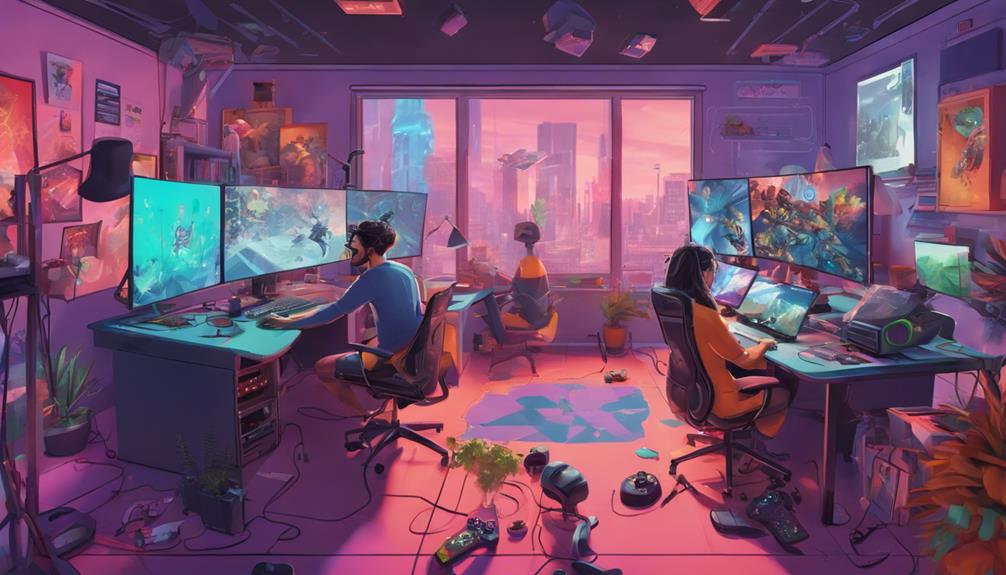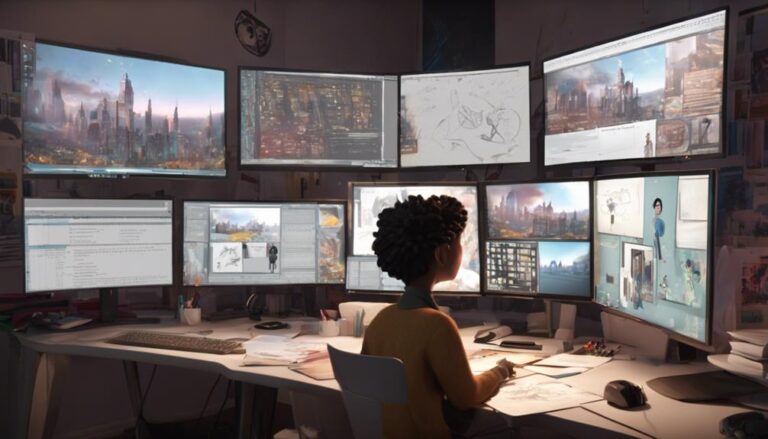Why Top Animation Studios Focus on Video Games
You're witnessing a shift in the animation industry as top studios focus on video games, driven by the multibillion-dollar gaming industry's vast financial potential. These studios are capitalizing on revenue models like game sales, in-game purchases, and subscriptions to drive growth and diversify their revenue streams. With video games, studios have more creative freedom to experiment with innovative game mechanics and artistic styles. They're also leveraging cross-platform storytelling opportunities to create immersive experiences that engage fans across multiple platforms. As you explore this convergence of animation and gaming, you'll discover more opportunities and innovations emerging at the intersection.
Key Takeaways
- Top animation studios focus on video games for vast financial potential and significant revenue generation opportunities.
- Video game development offers creative freedom and innovation, allowing for experimentation with unique game mechanics and artistic styles.
- Cross-platform storytelling and interactive content enable studios to create immersive experiences that cater to diverse audience preferences.
- Partnerships with game developers provide access to expertise, resources, and established networks that drive project success and attract new talent.
- Technological advancements, such as real-time rendering, elevate the art of storytelling and enable the creation of high-quality, immersive gaming experiences.
Financial Potential of Gaming
Into the multibillion-dollar gaming industry, animation studios are venturing, and the financial potential is vast.
You're likely to see significant investments in gaming as studios explore new revenue streams. Gaming investments can be lucrative, with some studios generating hundreds of millions of dollars in revenue from a single game.
The financial potential of gaming is closely tied to profit margins. As a key indicator of a studio's financial health, profit margins reveal how efficiently a studio can manage costs and generate revenue.
You'll find that top-performing studios have higher profit margins, which enable them to invest in new projects and expand their market share.
When evaluating the financial potential of gaming, consider the various revenue models, including game sales, in-game purchases, and subscriptions.
You'll also want to assess the market demand for different genres and the competition from established studios.
By analyzing these factors, animation studios can make informed decisions about their gaming investments and maximize their returns.
With careful planning and execution, studios can tap into the vast financial potential of the gaming industry.
Growing Demand for Interactive Content
The surge in demand for interactive content has transformed the way animation studios approach their projects. As you consider the evolving landscape, it becomes clear that the traditional linear approach to storytelling is no longer enough. User expectations have shifted, with audiences craving immersive experiences that allow them to engage with the content in new and innovative ways.
| Traditional Content | Interactive Content |
|---|---|
| Linear storytelling | Dynamic, branching narratives |
| Limited audience engagement | Real-time feedback and participation |
| Static, pre-rendered visuals | Dynamic, procedurally generated environments |
| Limited replay value | Endless possibilities for user-generated content |
The content evolution is driven by advances in technology and changing user behaviors. Animation studios must adapt to these shifts in order to remain relevant. By embracing interactive content, studios can create more engaging experiences that meet the evolving expectations of their audiences. As you explore the possibilities of interactive content, you'll find new opportunities for creativity and innovation in the world of animation.
Cross-Platform Storytelling Opportunities
Embracing interactive content opens up new avenues for cross-platform storytelling opportunities.
As you delve into the world of video games, you'll discover a unique chance to weave narratives that seamlessly transition across multiple platforms.
This approach allows you to craft immersive experiences that cater to diverse audience preferences.
By integrating story beats across different media, you can create a cohesive and engaging narrative that unfolds in various forms.
Transmedia narratives are a key aspect of cross-platform storytelling.
This approach involves developing a single narrative that spans multiple platforms, including video games, films, television shows, and web series.
By doing so, you can create a rich and interconnected universe that draws audiences in and keeps them invested in the story.
Effective story beats integration is crucial in transmedia narratives, as it ensures that each platform complements the others, providing a unified and engaging experience.
Increased Creative Freedom
When you venture into video game development, you'll find that this medium offers a unique set of creative possibilities.
Unlike traditional animation, where you're often bound by a linear narrative, video games provide a dynamic and interactive space for storytelling. This freedom allows you to experiment with innovative game mechanics, narrative structures, and artistic styles, which can lead to a more immersive and engaging experience for players.
As an animation studio, venturing into video game development can grant you artistic autonomy, enabling you to pursue projects that truly resonate with your creative vision.
This autonomy allows you to express yourself freely, unencumbered by the constraints of traditional animation. By embracing the medium's creative possibilities, you can explore new forms of creative expression, from interactive narratives to innovative gameplay mechanics.
This increased creative freedom can lead to the development of unique and captivating gaming experiences that showcase your studio's artistic vision and talent.
Collaborations and Partnerships
As you explore the possibilities of video game development, you'll likely find that partnering with other studios, developers, or publishers becomes a vital part of the process.
This is especially true for animation studios that are new to the gaming industry. Collaborations and partnerships can provide access to expertise, resources, and established networks that can help drive project success.
By partnering with experienced game developers, animation studios can tap into their knowledge of game development pipelines, engine technologies, and player engagement strategies.
This can help bridge the gap between animation production and game development, allowing studios to focus on their core strengths. Moreover, collaborations between animation studios and game developers can create powerful creative synergies, leading to innovative gameplay experiences and engaging narratives.
Effective partnerships can also help studios navigate the complex business side of game development, including publishing, marketing, and distribution.
As animation studios expand their reach into the gaming industry, strategic collaborations and partnerships will play a crucial role in their success.
Access to New Talent Pools
By leveraging partnerships and collaborations, you can tap into new talent pools and bring fresh perspectives to your video game development projects.
This is particularly true in the context of animation studios, where collaborations with game developers can provide access to emerging artists and fresh pipelines of talent.
By partnering with video game developers, animation studios can attract skilled professionals who are eager to work on innovative projects.
These partnerships can also provide opportunities for cross-training and knowledge sharing between animation and game development professionals.
For instance, animators can learn about game development pipelines and technologies, while game developers can gain insights into animation techniques and storytelling.
This exchange of knowledge can lead to the creation of new and innovative game development pipelines.
Moreover, by tapping into new talent pools, animation studios can stay ahead of the curve in terms of industry trends and technologies.
Emerging artists can bring new ideas and perspectives to the table, which can help animation studios to differentiate themselves in a competitive market.
Technological Advancements in Animation
Technological advancements in animation are rapidly transforming the industry, enabling studios to produce high-quality, immersive experiences that captivate audiences worldwide.
You're witnessing the rise of cutting-edge techniques that elevate the art of storytelling. One such innovation is motion capture technology, allowing studios to capture nuanced performances from actors and translate them onto digital characters. This results in more realistic character movements and expressions, drawing viewers deeper into the narrative.
Real-time rendering is another game-changer in the animation industry.
This technology enables studios to render animations instantly, eliminating the need for lengthy rendering times. As a result, you can experiment with different scenes, characters, and effects without sacrificing precious production time.
Real-time rendering also facilitates collaboration, allowing multiple artists to work on a scene simultaneously and see the results in real-time.
The integration of these technologies enables top animation studios to push the boundaries of visual storytelling, creating captivating experiences that resonate with audiences. By embracing these advancements, studios can stay ahead of the curve and deliver high-quality content that meets the ever-evolving expectations of modern viewers.
Diversifying Revenue Streams
By expanding your market reach through video games, you can tap into a vast and growing audience, increasing brand recognition and potentially attracting new fans to your animated content.
Developing multiple income sources, such as licensing your intellectual property or creating in-game merchandise, can also significantly boost your studio's revenue. By doing so, you can reduce financial risk and create a more sustainable business model, as your studio is no longer reliant on a single source of income.
Expanding Market Reach
As animation studios diversify their revenue streams, you're likely to see them making a more concerted effort to tap into the lucrative video game market.
This expansion into the gaming industry allows studios to capitalize on market trends and leverage their existing expertise in storytelling and character development. By doing so, they can attract new audiences and increase their global expansion efforts.
The video game market offers a vast and diverse landscape, with opportunities for studios to explore different genres, platforms, and business models.
- Global gaming communities: Tap into the massive global gaming communities, with millions of players worldwide.
- Cross-platform releases: Develop games that can be released on multiple platforms, including PC, console, and mobile devices.
- Esports and competitive gaming: Explore the growing esports and competitive gaming scene, with opportunities for sponsorship and revenue sharing.
- Virtual reality (VR) and augmented reality (AR) experiences: Create immersive VR and AR experiences that showcase their storytelling and visual expertise.
Multiple Income Sources
Diversifying revenue streams is no longer a nicety, but a necessity for animation studios looking to stay competitive in today's market. You're likely aware that relying on a single source of income can be detrimental to your studio's long-term success.
By expanding into video games, you can create multiple income sources, reducing your dependence on a single revenue stream. This not only helps you weather financial storms but also provides opportunities for growth.
A diversified portfolio can lead to merger opportunities, making your studio a more attractive partner or acquisition target.
By developing a range of revenue streams, you can demonstrate your studio's adaptability and resilience. This, in turn, can increase your studio's value and appeal to investors.
A diversified portfolio can also help you identify areas of strength and weakness, enabling you to make informed decisions about future investments and resource allocation.
Reducing Financial Risk
Expanding into video games can significantly reduce financial risk for animation studios, since it allows them to spread their revenue streams across multiple channels.
This is especially important in an industry where a single film's success can make or break a studio. By diversifying their revenue streams, animation studios can create financial cushions that protect them from economic downturns or unexpected failures.
Diversifying revenue streams is a key aspect of risk mitigation.
- Reduced dependence on a single title: By having multiple revenue streams, studios are no longer dependent on a single title's success.
- Increased financial stability: A diversified revenue stream provides a more stable financial foundation for studios.
- Improved cash flow: Multiple revenue streams can provide a steady flow of income, reducing the need for costly loans or investments.
- Enhanced ability to weather economic downturns: With a diversified revenue stream, studios are better equipped to survive economic downturns or industry disruptions.
Expanding Fan Engagement
You're likely aware that animation studios are now leveraging video games to connect with fans on a deeper level.
By creating immersive gaming experiences, these studios can engage new audiences who may not have been familiar with their work in other mediums.
This shift towards interactive storytelling methods allows studios to build a more personal relationship with their fans, fostering a sense of community and shared ownership.
Engaging New Audiences
By targeting new demographics and platforms, animation studios are successfully growing their fan base and fostering a sense of community among viewers.
You're likely part of the growing number of people who consume animation content across various platforms.
As studios expand their reach, they're paying close attention to fan demographics and youth preferences.
Understanding these demographics is crucial for studios to create engaging content that resonates with their audience.
Here are some key factors that studios consider when targeting new audiences:
- Age: Youth-oriented content is often designed to appeal to the 13-24 age group, with many shows and games featuring coming-of-age themes and relatable characters.
- Platform preferences: Studios are now creating content that's optimized for various platforms, including mobile devices, PC, and console gaming systems.
- Diversity and representation: Modern audiences crave diverse characters and storylines that reflect their own experiences and backgrounds.
- Interactive experiences: Studios are incorporating interactive elements into their content, such as virtual reality and augmented reality experiences, to create immersive and engaging experiences.
Interactive Storytelling Methods
Into the realm of immersive storytelling, animation studios are now delving deeper with interactive methods that revolutionize fan engagement.
You're witnessing a shift from traditional linear storytelling to dynamic, immersive narratives that put players at the forefront of the experience. This approach allows fans to engage with their favorite characters and worlds in unprecedented ways, fostering a deeper connection with the story.
By leveraging interactive storytelling methods, studios can craft unique experiences that cater to individual players' preferences and choices.
This dynamic approach enables the creation of complex, branching narratives that evolve based on player input. As a result, fans become active participants in the storytelling process, rather than passive observers.
The incorporation of interactive elements also enables studios to gather valuable feedback from fans, which can be used to refine and expand the narrative.
This collaborative approach not only enhances fan engagement but also helps studios refine their craft, creating more engaging and immersive experiences that resonate with audiences worldwide.
Blurring Lines Between Media
The intersection of animation and video games has led to an exciting convergence of media, with many studios now seamlessly blending elements from both worlds.
As you explore the fusion of animation and gaming, you'll notice how studios are pushing the boundaries of storytelling and artistic expression.
This media convergence is giving birth to new and innovative forms of entertainment.
You'll experience the thrill of this convergence in various ways:
- Immersive worlds: Richly detailed environments that transport you to new dimensions.
- Dynamic characters: Characters that evolve and adapt, responding to your actions and emotions.
- Interactive narratives: Stories that unfold based on your choices, making each experience unique.
- Merging of genres: The blending of animation and gaming styles, creating new and captivating genres.
As studios continue to blur the lines between media, you can expect even more innovative and engaging experiences.
The intersection of animation and video games isn't just about creating new forms of entertainment; it's also about expanding the possibilities of artistic expression and media convergence.
Frequently Asked Questions
How Do Studios Balance Film and Gaming Project Timelines?
When juggling multiple projects, you prioritize film and gaming timelines through effective project prioritization and resource allocation, ensuring key milestones are met and resources like talent and budget are efficiently distributed across each project.
Can Animation Studios Self-Publish Video Games?
You can self-publish video games, but consider development costs and distribution through publishing platforms like Steam, GOG, and the Epic Games Store, or mobile stores like Apple App Store and Google Play.
What Role Does Fan Feedback Play in Gaming Decisions?
As you analyze fan feedback, you'll see it drives gaming decisions through fan engagement and community analysis, helping developers refine gameplay, fix issues, and create content that resonates with their target audience's preferences and needs.
How Do Studios Handle Intellectual Property Rights in Gaming?
When handling intellectual property rights in gaming, you navigate licensing agreements, ensuring creators' rights are protected, and negotiate royalty rates to fairly compensate owners, balancing revenue and creative control in the gaming industry.
Are Gaming Industry Standards Applied to Animation Studios?
When you consider gaming industry standards, you'll find they often intersect with animation studios' artistic vision, as both prioritize immersive storytelling and engaging visuals, but industry trends ultimately dictate the extent of their application.
Conclusion
You're witnessing a seismic shift in the entertainment industry as top animation studios pivot to video games. The financial potential, growing demand for interactive content, and cross-platform storytelling opportunities are just a few reasons why. With increased creative freedom, collaborations, and technological advancements, studios can now diversify revenue streams and expand fan engagement. The lines between media are blurring, and you can bet animation studios will be at the forefront of this evolution.






